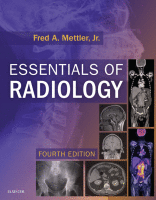Physical Address
304 North Cardinal St.
Dorchester Center, MA 02124

You’re Reading a Preview Become a Clinical Tree membership for Full access and enjoy Unlimited articles Become membership If you are a member. Log in here

Pediatric musculoskeletal imaging was covered in a special section at the end of Chapter 8 . Congenital cardiac lesions were covered in Chapter 5 . Table 9.1 shows the appropriate imaging tests for common pediatric problems. TABLE 9.1 Imaging of…

Introduction Fractures and other abnormalities involving the skull and face were covered in Chapter 2 . Initial imaging studies for a number of clinical problems are presented in Table 8.1 . A few general comments should be made about the…

Anatomy and Imaging Techniques The urinary system may be imaged in a number of ways. The initial studies of choice for many suspected clinical problems are shown in Table 7.1 . Historically, the most common radiographic method was intravenous injection…

Introduction Imaging Techniques and Anatomy The most common imaging study of the abdomen is referred to as a KUB, or plain image of the abdomen. The term KUB is historical nonsense. It stands for k idney, u reter, and b…

Normal Anatomy and Imaging Techniques The normal anatomy and configuration of the heart on a chest x-ray and on a computed tomography (CT) scan were discussed in Chapter 3 . Imaging of the heart also can be done with magnetic…

Imaging Methods Breast imaging generally refers to mammography. Mammography can detect a significant number of tumors not found by palpation or self-breast examination. Even if a mass is palpable, there are no reliable physical characteristics to distinguish benign from malignant…

The Normal Chest Image Technical Considerations Exposure Making a properly exposed chest x-ray is much more difficult than making x-rays of other parts of the body because the chest contains tissues with a great range of contrast. The range stretches…

Skull and Brain The appropriate initial imaging studies for various clinical problems are shown in Table 2.1 . TABLE 2.1 Imaging Modalities for Cranial Problems Suspected Cranial Problem Initial Imaging Study Skull fracture CT scan including bone windows Major head…

An Approach to Image Interpretation The first step in medical imaging is to examine the patient and determine the possible cause of his or her problem. Only after this is done can you decide which imaging study is the most…